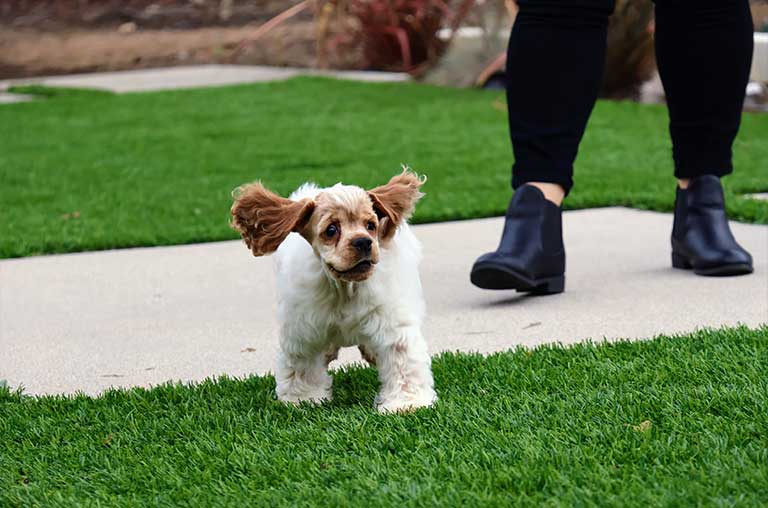Let us look at what to do when a dog has a seizure today. Seeing your pup in a seizure is one of the most disturbing and problematic things for a pet owner. However, it is not the time to panic and get confused. As a dog owner, one must be aware of what to do when a dog has a seizure.
If you have a cocker spaniel pup, seizure is one of the conditions are cocker spaniels prone to. However, seizure is not limited to a breed or some breeds of dogs. Any dog can get a seizure and it is important to know what to do when a dog has an epileptic seizure.
What Is a Dog Seizure Disorder?
Hearing that a small dog has a seizure is becoming more common these days. What is a dog seizure? We need to know this first before understanding what to do when a dog has a seizure.
Dog seizure is a condition where a dog looks confused and acts unsteady. Then they flop on the ground. They start to drool, twitch, and act like they are treading in the water.
These are the common symptoms of a dog seizure. If your dog shows all these symptoms that means it has a seizure disorder. Uncontrolled and abnormal bursts of electrical activity in the brains of a dog cause this type of seizure. It affects how they look and act. This abnormal behavior may end in a minute or can last for several minutes.
What Are the Causes of Seizures in Dogs?
Seizures are not a condition but they are symptoms. The causes of the seizures are numerous. The causes can be a severe head injury or due to low blood sugar. If the seizure is caused due to low blood sugar then we can tell that the dog has a diabetic seizure. However, the most common cause is called idiopathic epilepsy. That means the reason for the seizure is unknown. We even hear that an old dog has a seizure. It is hard to know the exact reason for this condition. Some dogs may get it through their parent’s genes.
However, if you find a dog has a partial seizure or full, the below are the could be the reasons.

- Liver disease.
- Eating toxic foods. Such as antifreeze or chocolate are toxic for dogs.
- Kidney disease.
- Liver shunts.
- Anemia.
- Encephalitis.
- Diseases such as distemper and rabies.
- Head injury.
- Strokes.
- High or low blood sugar.
- Brain cancer.
- Use of certain drugs.
What Are the Common Symptoms of a Seizure?
Before knowing what to do when a dog has a seizure, it is important to recognize whether your dog has a seizure or not. Here are the major symptoms to identify whether your dog has an epileptic seizure or not.
- A dazed look.
- Drooling.
- Unusual barking.
- Falling.
- Stumbling.
- Staring into space.
- Twitching.
- Chomping.
- Unconsciousness.
- Tongue chewing.
- Foam forming at the mouth.
- Uncontrollable pooping or peeing.
- Paddling motion using their legs.
Before the seizure, the dogs may look nervous, whine, and restless. They may drool and shake vigorously. After this, for a few seconds, the dogs may become wobbly, temporarily blind, and disoriented. Some dogs walk in circles and stumble upon things. On their chin, they may have a lot of drool.
If a Dog Has a Seizure, How Long Can It Last?
In the majority of cases, the seizures will last for a few seconds. In a few cases, it may last for a few minutes. If a dog has a seizure lasting for more than five minutes, one should immediately contact the veterinary doctor.
What Are the Types of Seizures in Dogs?
Focal Seizures
In this type of seizure, uncontrollable and abnormal electrical activity happens in one part of the brain. It results in seizures in one limb or one side of the body. Many seizures start as focal seizures and then become generalized. These seizures generally last for a couple of seconds.
Generalized Seizures
This type of seizure is called grand mal seizure. It is the most common type. The grand mal seizure is caused by the abnormal electrical activity in the brain. It can lead to unconsciousness and convulsion. It can last from a few seconds to minutes.
Idiopathic Epilepsy

Idiopathic epilepsy or temporal lobe seizures generally affect the pups of 6-month-old to 6-year-old dogs. This type of seizure can be found in any breed of the dog. However, this seizure is typically common in Australian shepherds, German shepherds, border collies, Labrador retrievers, Belgian Tervurens, collies, and beagles.
Psychomotor Seizures
If your dog has psychomotor seizures, that can lead to strange behavior and it can last up to a few minutes. They usually start chasing imaginary people or things and try to attack. Sometimes, they also try to catch their tail. Sometimes it becomes difficult to differentiate whether it is a psychomotor seizure or it is playing. But the dog has this disorder and does the same thing every time they have a seizure.
What To Do When a Dog Has a Seizure?
The main question that lies in the mind of every dog owner is what to do when a dog has a seizure. The first thing is not to panic and stay calm. If you think your dog might bump into some dangerous thing around it, you should slowly remove that and place it somewhere else. You can use a blanket to slide those objects gently without causing any disturbance.
Do not try to console your dog by staying close to it. If you stay near the dog’s head and mouth, they may unknowingly bite you. Do not put anything inside the dog’s mouth. You need not worry because dogs can’t choke on their tongues. It is better if you can make a video of the seizure so that you can show it to your vet, and it will help to identify the type of seizure and treat the same.
If the seizure continues for more than a couple of minutes, now your dog is at risk of overheating. To handle this, you need to turn on a fan and put cold water on the paws of your dog to cool down.

During the seizure, do not touch them since they might bite you without their knowledge. But you can talk to them softly and try to reassure them. Once the episode is over, immediately call your vet.
But if the seizure lasts for more than five minutes or, it is having frequent seizures in a short span, take them directly to the vet. The longer the seizure lasts, it poses more of a threat to your dog. If the seizure duration increases, it significantly increases body heat and may result in problems in breathing. This could ultimately result in damage to their brain. If you take your dog to the vet, they may give drugs to stop the seizure immediately.
Things to Remember If Your Dog Has an Epileptic Seizure.
- The below points are to be remembered when your dog is experiencing a seizure.
- Avoid your dog’s head and mouth. Don’t let yourself be hurt.
- Keep your dog away from the places where it can get hurt. Move away from stairs, sharp objects, and everything that can hurt him.
- Don’t put anything inside the mouth of your dog.
- Try to remain calm and record the complete duration of the seizure. It helps the veterinary doctor to treat it better.
The below things are to be remembered after your dog goes through a seizure.
- Watch your dog on its recovery. It may take a few minutes to hours.
- Let your dog hear your voice and feel your touch. Once they wake from the seizure, they need reassurance.
- Remain calm and talk gently. Animals can sense human feelings and emotions. If you are anxious, you can also become worried.
Which Foods Trigger Seizures in Dogs?
A few foods and beverages can lead to seizures in many dogs. Some of the foods which are safe for humans are not for dogs. They are:
- Caffeine.
- Raw bread dough.
- Chocolate.
- Alcoholic beverages.
- Too much salt.
- Artificial sweetener.
How Is Seizure in Dogs Treated?

If your dog has a seizure only once or once in a while is not a serious issue. And most of the time they do not require medication at all. Your dog needs medication for seizures in the following cases.
- If it is experiencing a violent seizure.
- Undergoes more than one seizure in a month.
- If the seizure lasts for more than five minutes.
- If your dog is one of the breeds which is prone to seizures. The breeds such as German shepherd, border collie, Saint Bernard, golden retriever, Irish setter, husky, or Keeshond.
You need to remember that once you start giving the medication to your dog, it has to be given throughout its lifetime. Stopping the medication can trigger a seizure.
Medications To Treat Seizures
The most common medications given by doctors are;
- Phenobarbital
- Zonisamide (Zonegran)
- Potassium bromide (K-BroVet)
- Levetiracetam
Your dog sometimes may need more than one medication. It is important to follow the instructions of the vet on how and when to give medication. Even if you are using the anti-seizure drug on your dog, sometimes they may experience seizures.
What Are the Other Treatments to Cure Seizures?
For some dogs certain things or situations trigger seizures. They are stress, fatigue, fireworks, etc. In that case, you need to avoid such situations. Other things that can help dogs are as follows.
Cannabidiol (CBD) Oil
In some studies, dogs given regular CBD oil along with regular medications, had fewer seizures than other dogs. But, we need more research on this.
Vagal Nerve Stimulation
If you anticipate a seizure in your dog, you can gently press on the closed eyes of your dog for 20 seconds. This helps to prevent the seizure. Repeat the same five times.
Traditional Herbs
Some dogs get better control of their seizures if you treat them with acupuncture and Chinese herbal remedies. But for these treatments, you need a trained practitioner.
Prescription Food

You can give your dog medium-chain triglycerides to prevent seizures.
However, you must consult with the vet before doing any of the remedies mentioned above.
What Happens When I Take My Dog to The Vet?
Once you take your dog to the vet, after the seizure, the first thing your vet will do is a physical examination. They will ask you whether your dog ate some toxic dog foods or incurred any severe injuries especially injury to the head. They may do an EKG to check if there are any health issues related to heart, kidney, blood sugar, liver, or electrolyte levels. They may also conduct tests using the dog’s pee and blood.
If necessary, the vet can also do some scans to detect the possible issues in the brain of your dog. Or else they may take a sample of the fluid surrounding your dog’s spinal cord and brain to check the abnormalities.
If your dog has idiopathic epilepsy, they will provide a few prescriptions to treat the same. If the seizure is caused by the consumption of some toxic food, the medication will help to remove the same from the dog’s body. And you need to avoid such food in future.
What Is the Life Expectancy of a Dog with Seizures?
The life expectancy of dogs with seizures can be the same as that of normal dogs if the owners take care of their pets with proper medications. If your dog is required to take medications regularly, and if you stop the medication, your dog may get a shorter life span.
Conclusion
To conclude, by now you know what to do when a dog has a seizure. It is alright if your dog has a seizure. Proper care and medication can make your pup live a normal life. However, many dog owners are not aware of what to do when a dog has a seizure. But I am glad you are not one of them, so be stress-free and enjoy your life.
FAQs
How Can I Help My Dog with a Seizure?
If your dog has a seizure disorder, do not panic. Talk to it and take it to the doctor immediately after the seizure episode. If it is once in a while, you can ignore the same. If your vet recommends taking medication, administer the medications as per the vet’s prescription.
Should I Give My Dog Anything After a Seizure?
Yes, you can provide some food or drink after the seizure. But ensure, the food you are giving is non-toxic and healthy. You need to be sure that it has completely recovered from the seizure. It is alert and stands without any confusion or wobbling.
What Triggers a Seizure Dog?
Many things can trigger seizures in a dog. The main triggers for seizures are toxic food, drugs, stress, anxiety, excitement, heat exhaustion, idiopathic epilepsy, falling asleep or waking up, etc.
Can Dog Seizures Be Cured?
The seizures that appear once in a while will be cured without medications. But if it is idiopathic epilepsy, it cannot be cured. Once you start giving the medication to your pup, it has to be given throughout its life. If you miss the medications, it can trigger seizures.
Is There a Natural Way to Stop Seizures in Dogs?
Yes, some dogs recover from seizures with natural remedies such as using CBD oil, Chinese herbal remedies, and acupuncture.

Leave A Comment